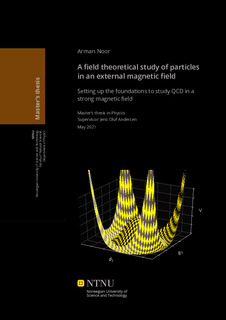A field theoretical study of particles in an external magnetic field Setting up the foundations to study QCD in a strong magnetic field
| dc.contributor.advisor | Andersen, Jens Oluf | |
| dc.contributor.author | Noor, Arman | |
| dc.date.accessioned | 2021-09-28T18:41:21Z | |
| dc.date.available | 2021-09-28T18:41:21Z | |
| dc.date.issued | 2021 | |
| dc.identifier | no.ntnu:inspera:80800066:46763709 | |
| dc.identifier.uri | https://hdl.handle.net/11250/2785581 | |
| dc.description.abstract | I denne master oppgaven studerer vi forskjellige typer partikler i et konstant magnetisk felt. Grunnen til det er for å få et grunnleggende forståelse og skape fundamentale verktøy til å undersøke QCD i sterke magnetiske felt. Vi begynner med å undersøke frie teorier av både spin-0 og spin-1/2 partikler. Vi bruker den imaginære tids formalismen til å kalkulere partisjons funksjonen av de tilsvarende teoriene og utrykker dem som sti integraler. Ved bruk av dette utrykket for partisjons funksjonen kan vi kalkulere alle termodynamiske verdier som for eksempel energi tettheten til systemet vårt. Vi ser at energi tettheten har både et vakum bidrag og et avgrenset temperatur bidrag. I denne avhandlingen fokuserer vi bare på å kalkulere vakum bidraget til energi tettheten, nemlig når temperaturen er null. Vi fortsetter med å undersøke interaksjonen av spin-0 og spin-1/2 partikler med et konstant magnetisk felt. Vi kan finne felt ligningene for de tilsvarende teoriene og representere bølgefunskjonene som Landau eigenfunskjoner til de tilsvarende Landau energi levelene. Etter å ha funnet felt ligningene kan vi bruke bølge funskjonene til å kalkulere propagatoren til tilsvarende teorier ved bruk av Schwinger sin ordentlige tids formalisme. Til slutt kan vi bruke disse propagatorene til a kalkulere vakum energi tettheten til felt teoriene som vi er interessert i. Som vi ser er vakum energi tettheten divergent som betyr at vi må regularisere og renormalisere resultatet vårt slik at vi får et fysisk rimelig sluttsvar. Etter å ha studert frie teorier begynner vi å se på interaksjons teorier ved bruk av phi i fjerde model. Vi ser på spontant symmetry knusing av systemer med kvartiske interaksjoner. Vi fokuserer her bare på skalar partikler, finner en generalisering til N virkelige skalarer ved bruk av lineær sigma modellen, og spesialiserer til teorier med fire virkelige skalarer, nemlig N=4. Vi fortsetter med å kalkulere den effektive potensialen til slike systemer som tilsvarer vakum energi tettheten til det systemet. Igjen er resultatet vårt divergent og dermed må vi bruke dimensjonel regularisasjons metoder og MS bar renormalisasjons ordningen. | |
| dc.description.abstract | In this thesis we study the interaction of different types of particles with a constant magnetic field. The purpose of this is to gather a basic understanding and develop fundamental tools in order to explore QCD in a strong magnetic field. We thus start with exploring free theories of both spin-0 and spin- 1/2 particles. We use the imaginary time formalism to calculate the partition function of the respective theory which is expressed as a path integral. Using this expression for the partition function, we can calculate any thermodynamic quantity such as the energy density of the respective system. We see that the energy density has both a vacuum contribution and a finite-temperature contribution. In this thesis we only focus on calculating the vacuum contribution to the energy density, namely when temperature is zero. Next, we investigate the interaction of a spin-0 particle and a spin-1/2 particle with a constant magnetic field. We can find the field equations of the respective theories and represent the wavefunctions as the Landau eigenfunctions of the corresponding Landau energy levels. Having found the wavefuntions, we can use them to calculate the propagator for the respective theory using the Schwinger proper time formalism. Finally, we use these propagators to calculate the vacuum energy density of the field theories. As we see, the vacuum energy density is divergent which we regularize using both dimensional regularization and a cutoff scheme. Finally, we renormalize our result to obtain a physically reasonable expression. Having investigated free theories, we then proceed with interacting theories using the phi^4 model. We explore spontaneous symmetry breaking of systems with quartic interactions. We focus here only on scalar particles, find a generalization to N real scalars using the linear sigma model, and specialize to the case of two complex scalar fields, which is equivalent to a theory of four real scalars, namely N=4. Proceeding, we calculate the effective potential of such systems which corresponds to the vacuum energy density of the system. Again, we obtain divergent results. We regularize the results using dimensional regularization and the MS bar renormalization scheme. | |
| dc.language | eng | |
| dc.publisher | NTNU | |
| dc.title | A field theoretical study of particles in an external magnetic field Setting up the foundations to study QCD in a strong magnetic field | |
| dc.type | Master thesis |
Files in this item
This item appears in the following Collection(s)
-
Institutt for fysikk [2653]
